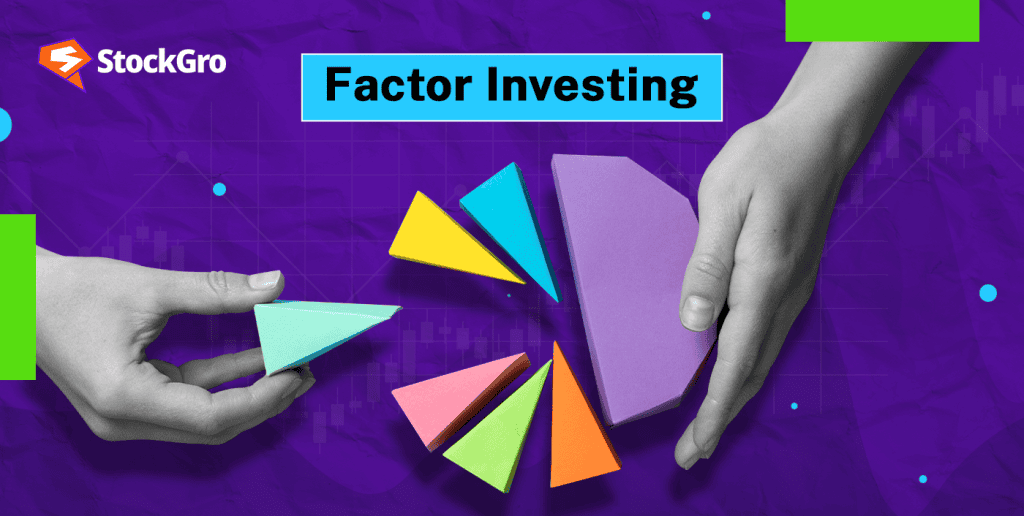
As stock market investors seek more organised and data-driven strategies to increase portfolio returns, factor investing is growing. Focussing on value, momentum, or low volatility, factor investing allows investors to profit from systematic return drivers while minimising risk. These strategies are increasingly applicable for institutional and retail investors in India’s unpredictable and expanding markets.
Factor investing balances risk and return with market-beating factors. This essay will discuss factor investing methods, single-factor and multifactor models, and real-world examples of how Indian investors might improve risk-adjusted returns.
Learn more about: Investing Profits from Side Ventures
What is factor investing?
In factor investing, particular features, or “factors,” are identified and used to maximise portfolio returns and limit risk. Factor investing leverages continuous drivers of return including value, growth, and volatility to create more organised and predictable strategies than traditional investment, which have their focus on market patterns or stock analysis.
Factor investing seeks to profit from these elements’ past stock market effects. Strategic portfolio management can outperform market indices by focusing on particular aspects. The following are commonly used to create factor investing methods. This strategy allows investors to optimise performance and control risk more precisely, independent of market conditions.
| Factor | Description | Investment Focus |
| Value | Investing in inexpensive equities to profit from price corrections. | Stocks with low price-to-earnings (P/E) or price-to-book (P/B) ratios. |
| Growth | Targeting companies with strong earnings growth potential, expecting higher future performance. | Companies with high earnings growth rates or expanding revenues. |
| Momentum | Buying stocks with rising prices to capitalise on momentum. | Consistently rising stocks. |
| Volatility | In unstable markets, choosing equities with lesser price swings decreases risk. | Low-volatility stocks with stable price movements. |
Understand more about: What exactly is a factor market?
Key factors in investing strategies
Factor investing strategies focus on specific aspects that influence stock market performance, such as maximising rewards and avoiding risks.
The value factor is a popular method in which:
Equities are purchased at a discount to their real worth. Undervalued stocks are expected to recover when the market corrects, boosting returns. Value investing capitalises on market inefficiencies but requires patience.
Momentum factory strategy:
Targets rising equities. Investors select stocks with steady price growth to capitalise on momentum. With short-term returns, momentum investing requires careful monitoring and timing to avoid overpaying for equities because trends can quickly reverse.
The low volatility feature highlights:
Stocks with lesser price movements to reduce risk. During market uncertainty, this strategy is known to generate more consistent, but modest, outcomes. The approach is commonly adopted by investors who want to preserve their wealth while still generating consistent returns.
Collectively, these strategies contribute to the development of a diversified portfolio. Factor investing models balance risk and reward by including characteristics such as momentum, low volatility, and value, allowing investors to achieve more consistent, long-term performance across market cycles.
Benefits of factors investing
- Factor investing focuses on historically successful variables like low volatility, momentum, or value.
- By isolating these factors, investors can more effectively manage risk and pursue higher returns than they could through conventional stock selection.
- The reduction of market risk is facilitated by the integration of multiple factors, such as growth, momentum, and low volatility.
- Multi-factor strategies mitigate dependence on a single factor by maintaining portfolio performance in the face of fluctuating market conditions.
- Using data and predetermined parameters, factor investing mitigates emotional influences such as panic selling or trend-chasing.
- This methodical approach enhances the consistency and rationality of investment decisions.
Factor investing models: A structured approach
Factor investing models are crucial for the development of data-driven, disciplined portfolios that concentrate on predetermined, specific factors. By establishing a systematic framework for stock selection, these models guarantee consistency in decision-making and mitigate the emotional fallacies that are frequently observed in conventional investing.
| Model type | Description |
| Single-factor model | Concentrates on a single critical factor, such as momentum or value, enabling investors to pinpoint precise performance determinants. |
| Multi-factor model | Balances risks and optimises returns by integrating several factors, including momentum, value, and low volatility. |
Despite the simplicity of single-factor models, investors may face significant risk if the chosen component fails to perform as projected. In contrast, multi-factor models provide diversification across numerous factors, reducing risk by not relying on a single market driver. This diversification method increases the stability of long-term performance.
These models’ core strength is quantitative analysis, which assesses equities using historical data and statistical approaches. The reduction of subjective assessment and market sentiment allows investors to use a consistent, evidence-based strategy. Factor investing models make stock-picking more methodical and risk-managed, providing risk-adjusted profits.
Know more about: Key risks in investing in the stock market
Conclusion
Factor investing is a data-driven, disciplined strategy that enhances portfolio performance by emphasising key return drivers such as value, momentum, and low volatility. Integrating these traits helps investors diversify, reduce market exposure, and maximise risk-adjusted returns.
Through mathematical analysis, factor investing models simplify company selection and minimise emotional biases. Using single or multi-factor models, factor investing maximises profits more consistently in a variety of market conditions. These methods can help investors maximise their potential in the ever-changing stock market while balancing risk.
FAQs
- Is factor investing good?
Factor investing works because it targets variables like low volatility, momentum, and value that have consistently produced superior risk-adjusted returns. Using a more systematic and scientific approach than traditional stock-picking improves long-term performance and risk management.
- What are the benefits of factoring?
Factor investing diversifies, improves risk-adjusted returns, and lowers market volatility. It uses quantitative analysis to decrease emotional decision-making and create a methodical investment approach. This enables investors to identify consistent performance variables and maintain the balance of their portfolios in the face of changing market conditions.
- What is factoring in the stock market?
Factor investing in stocks involves finding factors like value, growth, momentum, and volatility that have historically influenced returns. These criteria help investors create systematic, data-driven portfolios that outperform the market.
- What is the difference between factor investing and index investing?
Index investment passively tracks a market index, while factor investing capitalises on momentum or value. Index investing gives broad market exposure at a lower cost but with less precision, whereas factor investing allows greater customisation and the possibility of outperformance.
- What is 5-factor investing?
5-factor investing involves value, scale, momentum, profitability, and investment. These factors are statistically linked to higher returns and utilised to build a diversified portfolio that can outperform over time while minimising risk throughout market cycles.

